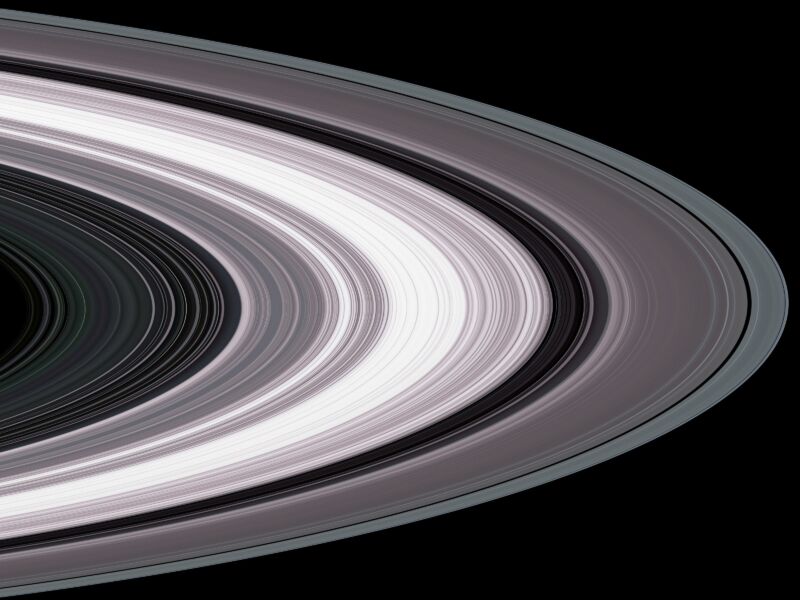The formation of a gas giant involves a race against time. Planets come into being as newly forming stars heat up, a process that quickly drives all the stray gas out of the planet-creating regions nearby. To create a gas giant, a large, rocky planet has to form prior to this process and generate a large enough gravitational pull to draw in gas before it's all pushed away.
The process should leave planets like Jupiter and Saturn with a solid, rocky core buried deep within the envelope of gas. But confirming that core composition has been difficult. Now, researchers have used features in Saturn's rings to detect subtle gravitational influences from the core. While not definitive, the results suggest that the core is large, and the solid, rocky portion is widely spread out across that area.
A layered look?
Planets like the Earth and Mars were hot enough during their formation to establish a layered structure, with the heaviest elements at the core and lighter materials above. The same should occur in a planetary body that is large enough to draw in a massive gas envelope. As a result, early models of gas giant interiors suggested a series of layers: a metallic inner core surrounded by a rocky layer, and then metallic gasses compressed by the layers of gaseous atmosphere above them.
By tracking the movement of the Cassini probe around the system, we got some data on Saturn's gravitational field. Additional data has come from recognizing that the motion of materials within the planet also creates regions of altered density in the rings, building patterns that can be imaged when the rings are backlit by the Sun.
The new work relies on the features of the waves we've detected within Saturn's rings. In essence, the researchers built multiple models of what Saturn's core could look like and check whether the models would create the patterns we actually see. The real-world data is then used to put constraints on the possible elements of Saturn's core.
The mere existence of certain features in the rings, for example, means that there must be some internal divisions in Saturn's interior. The features are formed through the influence of internal gravity waves (note: not gravitational waves) in the inner core. The presence of gravity waves implies that there's a boundary between two layers, separated by something like density or chemical composition, that maintains their distinctness against any internal convection in the core.
Setting limits
Overall, the ring features help rule a lot of elements out. For example, if there were a sharp boundary between the core and the gas envelope, the waves seen in the ring would have a high frequency. Since that's not the case, the border between the two has to be somewhat blurry. At the same time, the boundary can't be so blurry that there are no clear boundaries between layers within Saturn's interior. If that were true, there would be no way to produce one of the features seen in the ring.
Overall, the models that fit the data place Saturn's core-envelope boundary a significant distance from the planet's center, roughly 60 percent of the way to the surface. That's a radius of nearly 60,000 kilometers, or over nine times Earth's radius.
The exact composition of the core is much harder to figure out, since the constraints are fairly wide. The total mass of heavier elements in the core is about 19 times Earth's mass, consistent with models of gas-giant formation that place rock and iron at the center, although a lot of this material could also be water ice. Yet the total mass of the core could be as high as 55 times the Earth's mass, indicating that there's a lot of other material there—likely metallic hydrogen and helium.
If hydrogen makes it to the inner core, it should form a metallic fluid that can easily mix with iron and silicate rocks.
In any case, it's clear that the neatly structured layers we might expect to exist based on planetary formation models don't actually seem to be there. Combined with hints that Jupiter may also have a diffuse core, this idea would seem to favor alternative models in which the planetary cores of gas giants don't undergo the same evolutionary processes seen in rocky bodies.
The alternative is that the core has become diffuse, as the conditions of the inner core would turn hydrogen into a metallic fluid that can easily mix with iron and molten silicate rocks. So it's possible that an early, layered structure slowly eroded and dissolved over time.
Still, this paper should not be viewed as the final word on what's going on inside Saturn. Even after trying multiple ways of matching the data, the researchers conclude that "none of the models are entirely satisfactory," which means there are plenty of opportunities for researchers to tweak parameters or add features to get a better fit.
Nature Astronomy, 2021. DOI: 10.1038/s41550-021-01448-3 (About DOIs).



3175x175(CURRENT).thumb.jpg.b05acc060982b36f5891ba728e6d953c.jpg)

Recommended Comments
There are no comments to display.
Join the conversation
You can post now and register later. If you have an account, sign in now to post with your account.
Note: Your post will require moderator approval before it will be visible.